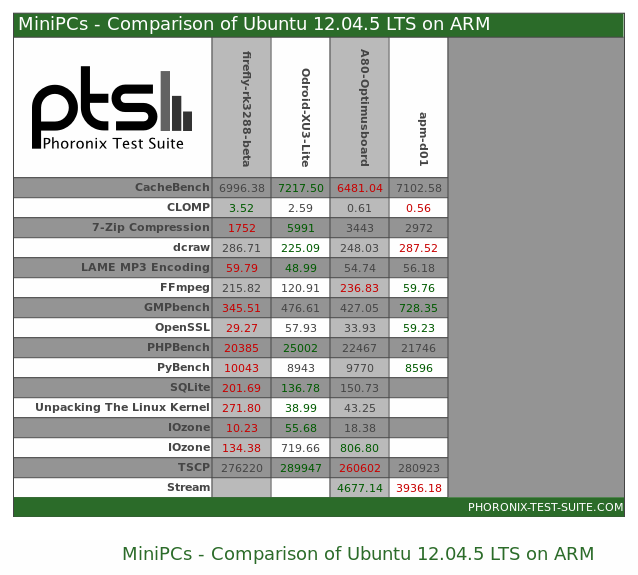With all these Intel Atom Z3735F been released right now at a price similar to ARM based mini PCs, many people, including myself, are wondering about the performance of the low cost Intel processor against their ARM competitors. Ian Morrison just published some results from Phoronix Test Suite comparing the performance of Firefly-RK3288 (Rockchip RK3288), ODROID-XU3 Lite (Samsung Exynos 5422 BIN2), and A80 OptimusBoard (Allwinner A80) in Linux (Ununtu 12.04.5), against the performance of MeegoPad T01 (Intel Atom Z3735F) running Linux from a Live CD on a USB drive.
 Some of the benchmarks failed because Phoronix Test Suite got apparently confused with the file systems located on a USB drive, but at least we’ve got a comparison point, and the results are a bit confusing, as they’re no clear winner. In some tests like FFmpeg, the Intel SoC really crushed the ARM competition being at least twice as fast as Exynos 5422, and about four times faster than RK328 and A80, maybe because of x86 multimedia extensions (SSE4), while in the CLOMP (OpenMP) benchmark it’s the slowest processor, even 6 times slower than on Rockchip RK3288. But overall, Intel Atom Z3735F seems to be a very good performer. We’ll also have to see some GPU benchmark (in Android) to compare these two ARM and x86 SoCs.
Some of the benchmarks failed because Phoronix Test Suite got apparently confused with the file systems located on a USB drive, but at least we’ve got a comparison point, and the results are a bit confusing, as they’re no clear winner. In some tests like FFmpeg, the Intel SoC really crushed the ARM competition being at least twice as fast as Exynos 5422, and about four times faster than RK328 and A80, maybe because of x86 multimedia extensions (SSE4), while in the CLOMP (OpenMP) benchmark it’s the slowest processor, even 6 times slower than on Rockchip RK3288. But overall, Intel Atom Z3735F seems to be a very good performer. We’ll also have to see some GPU benchmark (in Android) to compare these two ARM and x86 SoCs.

Jean-Luc started CNX Software in 2010 as a part-time endeavor, before quitting his job as a software engineering manager, and starting to write daily news, and reviews full time later in 2011.
Support CNX Software! Donate via cryptocurrencies, become a Patron on Patreon, or purchase goods on Amazon or Aliexpress




